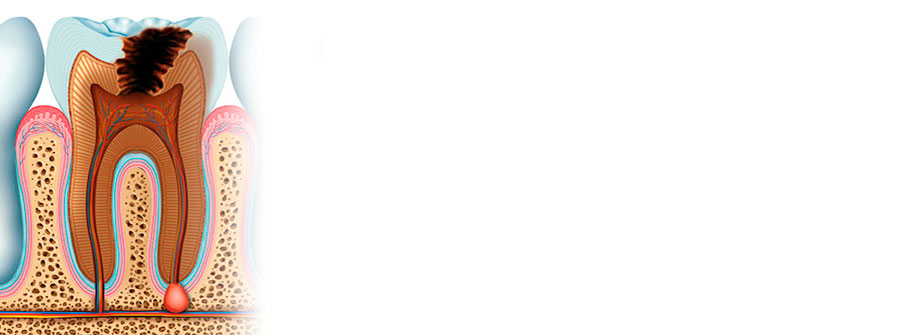ENDODONTICS
An Endodontics is a root canal treatment. This corresponds to all therapy that is practised in the dental-pulp complex (that is, the dental pulp and its teeth) of a tooth.
This is applied in fractured dental pieces, with deep cavities or when the pulp tissue is injured (loose connective tissue) in which this symptomatology is characteristic, pulpitis.
This lesion can be reversible or irreversible, when the only therapeutic option in endodontics is the total removal of the dental pulp, and the three-tridimensional filling of the dental canal.
Endodontics can be classified into three types:
![]() Uniradicular endodontics: When in the endodontics, it is noted that it affects a piece which has only one root and one pulp canal.
Uniradicular endodontics: When in the endodontics, it is noted that it affects a piece which has only one root and one pulp canal.
![]() Biradicular endodontics: When it is noted that it affects a piece with two roots and two pulp canals.
Biradicular endodontics: When it is noted that it affects a piece with two roots and two pulp canals.
![]() Poliradicular endodontics: When it is noted that it affects a piece with more than two roots and several pulp canals.
Poliradicular endodontics: When it is noted that it affects a piece with more than two roots and several pulp canals.
In order to know whether we need an endodontics, different symptoms may be manifested that can alert us to this need, and if we have them, perhaps we need an endodontics: the dental piece is discoloured and darkened or there is pain when the tooth is exposed to hot or cold stimuli in a tooth with a cavity. There may be an injury to the tooth or a restoration from which it has not recovered.
Sometimes it does not hurt and the lesion with a cavity has already affected the pulp irreversibly. To be able to make a diagnosis, an exploration by a specialist is required, and it is necessary to preform a prior x-ray, and this way it will be
known if an endodontics is necessary.
Frequent questions about endodontics:
- What are the symptoms that indicate the need of an endodontics treatment?
Some of the symptoms that must be taken into account are pain, prolonged sensitivity to heat or cold, discolouration of the tooth, besides inflammation and sensitivity in the adjacent gums. However, sometimes there is not any type of symptomatology.
- What happens when the dental pulp is injured?
The dental pulp is the soft tissue inside of which are found the nerves, the blood vessels and the connective tissue. This is located inside the tooth and it extends from the crown to the end of the root, which is found in the maxillary bone.
When the dental pulp has an infection or suffers injury, it can not be regenerated, it dies. The most common causes for the death of the pulp are the fracture of a tooth or the existence of a deep cavity. Both lesions allow the entrance of germs (bacteria) to the dental pulp. The germs can cause an infection inside the tooth. If the infection is not treated, an accumulation of pus at the end of the root becomes a “bag of pus” named an abscess. Abscesses can damage the bone that surrounds the tooth.
- Why is it necessary to remove the pulp?
When it is not removed, the infected dental pulp can cause pain and inflammation. Some problems derived from the infection may damage the jaw. If the tooth does not undergo treatment, it probably will have to be extracted.
- What is the treatment?
In general terms, the treatment involves one to three visits. During the treatment the dentist removes the sick dental pulp. Once the cleaning of the canals is finished, the pulp chamber is shaped and the radicle canal(s) of the tooth are sealed.
- How long does the repaired tooth last?
Once repaired, the tooth could remain healthy for the patient´s whole life,
as long as he takes care of his teeth and gums. However, it is necessary to undergo controls regularly. As long as the root(s) of the repaired tooth are nourished by the surrounding tissue, the tooth will remain healthy.
- Is it necessary for the tooth to receive any special care or other treatment?
You must not bite with the treated tooth until your generalist dentist has restored it definitely, as the tooth could be fractured. In all other respects, do not forget to put good oral hygiene into practice: brush your teeth, use dental floss, undergo controls and dental cleaning regularly. Teeth that receive an endodontics treatment can have a useful life of many years, even for the
patient´s whole life.
When a canal treatment is performed on a tooth (endodontics), and the destruction of the tooth is very severe, the only possible treatment that can be carried out is a bolt or stump, and if it is not so severe, the crown of the tooth can be reconstructed with a traditional restoration (composite, amalgam, etc.).
It will also be sometimes necessary to put a crown or a cap on to protect the tooth that has had an endodontics treatment.





